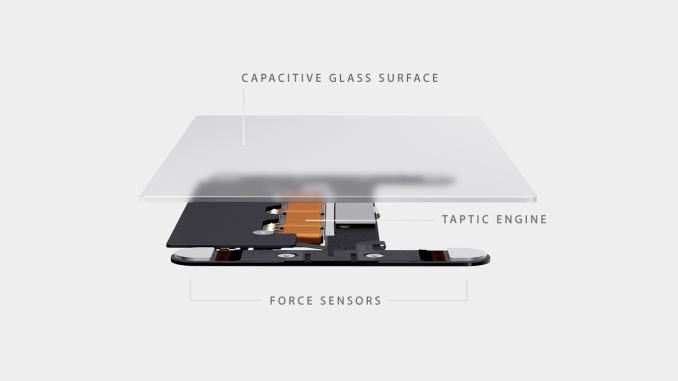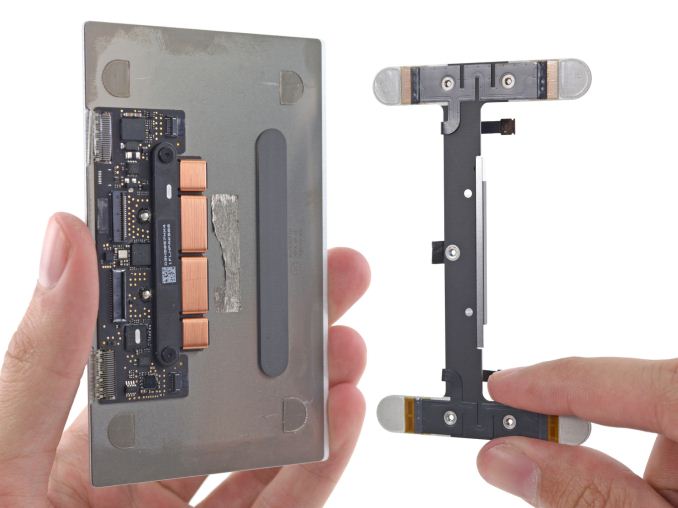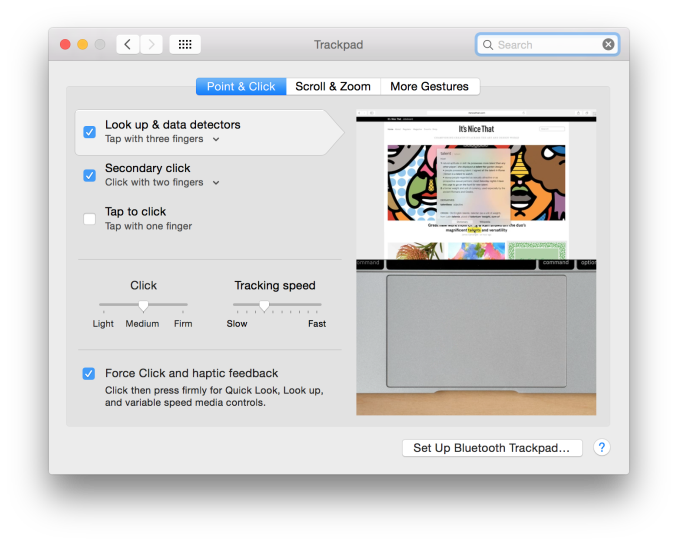The 2015 MacBook Review
by Ryan Smith on April 14, 2015 10:15 AM ESTForce Touch Trackpad
Along with Apple’s changes to their keyboard, the company has also gone in and significantly reworked their trackpad. The new Force Touch Trackpad represents the biggest change to Apple’s trackpad design since the creation of the capacitive, multi-touch pivoting trackpad introduced on the unibody MacBook Pro. In putting together the Force Touch Trackpad, Apple has significantly reworked the internals of the trackpad, creating a trackpad that behaves a lot like their traditional trackpad with some new features, but under the hood relies on some very different mechanisms.
The big change here is that Apple has done away with the traditional pivot and switch mechanism. With pivot and switch, the capacitive trackpad surface would act like a small touchscreen, and underneath it was a switch to register when the trackpad was pressed down. Mechanically the trackpad pivoted from the top (Apple likes to compare it to a diving board), with the trackpad inferring what action to take based on the combination of the capacitive readings and the switch reading. Multi-finger gestures would rely solely on the capacitive layer, primary/secondary clicks would be based on the number of fingers in use when the switch was actuated, etc.
The Force Touch Trackpad on the other hand eliminates the pivot and switch mechanism in favor of a combination of an electromagnet and force/pressure sensors. The pressure sensors essentially replace the physical switch, allowing the trackpad to tell when it has been pressed based on the amount of pressure, and thanks to the pressure sensors it can now tell how hard it has been pressed as opposed to the binary nature of the physical switch. Meanwhile without a physical switch in place to provide the clicking sensation and feedback of pressing down on the touchpad, Apple’s electromagnet – the Taptic Engine – activates to simulate the feeling and noise of pressing a switch.
Update 04/15/2015: iFixit has a great shot of the trackpad's internals, including a good look at just how big the electromagnet/taptic engine really is.
The end result is that the MacBook’s trackpad is among the first wave of devices that ships with Apple’s next generation trackpad and the enhanced capabilities that go with it. Ignoring the pressure sensitivity for a moment (we’ll get back to it), replacing the pivot and switch for an electromagnet works shockingly well. From a touch & feel standpoint the Force Touch Trackpad feels virtually identical to a traditional trackpad, to the point where it’s more than a bit uncanny. In practice you are not actually triggering a switch nor is the trackpad really moving (technically it’s deforming ever so slightly), but it sure feels like you’re working a switch. Apple has clearly done their homework on getting an electromagnet to emulate a switch, to great results. Meanwhile they don’t have the trackpad’s acoustics precisely matching a switch, but the resulting pinball-machine like plunk is close enough to a click that I don’t imagine anyone will mind the difference.
One side benefit of this change is that the trackpad feels the same throughout, and unlike the pivoting trackpad does not require more or less force depending on where you are relative to the pivot point. The variable force required has never been a major problem in my experience, but it is nice to no longer need to worry about where your fingers are relative to the top, and consequently how much force you need to use.
However the bigger deal is that by making the amount of force required to click consistent throughout the entire trackpad, Apple can now use the amount of pressure applied as another input, making the trackpad pressure-sensitive. The underlying pressure sensors and electromagnet are by default programmed to have two levels of feedback – a shallower press is equivalent to a click – and a deeper press brings about the pressure-sensitive “Force Click.” What force clicking does depends on the application, and right now it’s clear that Apple is still experimenting with what they can do with pressure sensitivity. The most obvious uses include line thickness in drawing applications, but the company is also using it for things such as variable speed fast forward and rewinding in QuickTime/iMovie. At times the force click is treated like a 3rd (tertiary) click, and other times the result is based on variable pressure. Since this is a new (and uncommon) feature there’s no global action assigned to the force click – nor does it behave as a middle click on a regular mouse – so what happens is up to the application.
In implementing force click and the Force Touch Trackpad, Apple does offer the ability to control the amount of pressure required and whether force click is active. With force click deactivated the trackpad behaves more or less identical to a traditional trackpad with a single click level. Meanwhile the click pressure setting is interesting, though I’m not entirely convinced it’s all that effective. Short of the tools to actually measure click pressure, I’m not so sure Apple is changing the amount of pressure required to trigger a click so much as they’re changing how hard the electromagnet vibrates. The feedback change is certainly very subtle going from light to firm, and if there is a change in the amount of pressure required then it is certainly equally subtle.
Ultimately whether the Force Touch Trackpad is a major upgrade or not is going to depend on a user’s ability to make use of the force click features. Even turned off, the new trackpad is essentially an improved version of the old trackpad without the minor drawbacks of the pivot mechanism. But with the force click turned on, then it brings new (though not always useful) actions to the trackpad that in turn makes it a bigger upgrade over the old trackpad.
In any case, the MacBook along with the 2015 MacBook Pro 13” are the first wave of devices to implement the new Force Touch Trackpad. Given its expanded capabilities I would expect Apple to eventually replace many (if not all) of their trackpads with this new design. Certainly the 15” MacBook Pro is a likely candidate, as is a future version of the Magic Trackpad. What remains to be seen is whether the next MacBook Air also gets this new trackpad, or if Apple withholds it to keep the products differentiated and to keep the costs of the MacBook Air down.














354 Comments
View All Comments
Peichen - Wednesday, April 15, 2015 - link
UX305 is also 28% heaviertipoo - Tuesday, April 14, 2015 - link
As a CS student I'm always using external drives, and some workloads are moderately demanding. I'd just go for the 13" Air or Pro, and spring for the latter if you can.Regular Reader - Tuesday, April 14, 2015 - link
I would agree that this new model is most likely a replacement for the MBA It's everything the MBA needs to be, sans CPU power, but even that is arguable. In fact, the CPU might be my only gripe with the thing (though I'm sure I'd go mad over the single port issue after about a week). Apple seems to me to have been on a course over the last 5 years to use its devices to draw clear divisions between people who actually need power - the MBP buyer - and people who need just enough power to do core tasks (email, web, document handling, very mild gfx work). Unfortunately I fall somewhere in the middle, so I want the 16GB of RAM and quad core CPU, I just don't want the added bulk associated with even a 13" MBP. I'd be willing to give up battery running time to get that, too.HunterKlynn - Tuesday, April 14, 2015 - link
"I suspect Apple finally sacrificed the logo to further save on power."Isn't the logo just a clear piece of plastic that's lit up by the already running display back light? That shouldn't have any power cost whatsoever?
TEAMSWITCHER - Tuesday, April 14, 2015 - link
I think they sacrificed the Logo for the color Space Gray and Gold color schemes, maybe to save power by reducing the backlight intensity. They place a highly reflective film coating on the inside of the "lid" to reflect the backlight forward...without a Space Gray and Gold color distortion.Ryan Smith - Tuesday, April 14, 2015 - link
Any light you're not reflecting back towards the front is light you're wasting, especially on a power constrained system such as the MacBook.HunterKlynn - Tuesday, April 14, 2015 - link
That's true, I just figured it would be an immeasurably small amount wasted illuminating the logo.wiz329 - Tuesday, April 14, 2015 - link
Out of curiosity, how does this work on all other Mac laptops? IE -- how do they avoid having a dim, Apple shaped dark spot on the screen since light it escaping out the back?Calista - Tuesday, April 14, 2015 - link
Can we in six months expect a cut-down version of the Macbook with only 4/128 GB but far cheaper? Somehow it seems like a sufficient solution for replacing the MBA which quite frankly feels like the odd fellow. It had its place when the MBP was 5+ lbs, but today?modulusshift - Tuesday, April 14, 2015 - link
Nope, not in six months, not in six years. Apple isn't that kind of company. The Watch starts at a hundred dollars more than any of its competitors. Frankly I'm still a little amazed that the 11 inch exists at that performance point in the first place, it really isn't able to sustain even its current performance over the next few years.Anyhow, the MacBook is the premium line now, which means it needs to have a great experience even at the lowest price point. People's opinions form quickly and don't change for years. Up until recently, there were still deniers that the MBA had enough performance for anything important just because the first one happened to ship with an HDD instead of a (ridiculously expensive) SSD.